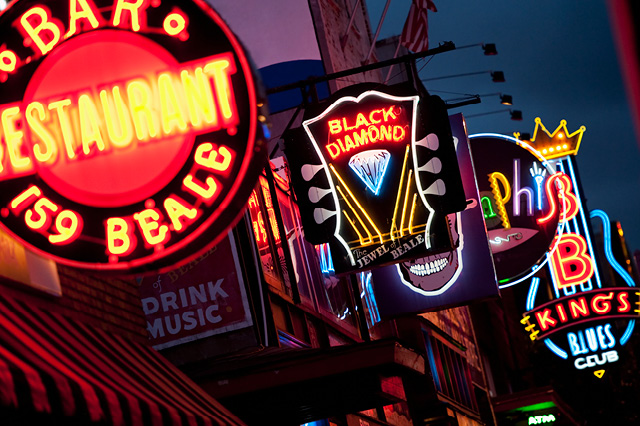When the music started, the people who had been standing around began to tap their toes, bounce their heads and move their hips to the beat. But this wasn’t a dance hall or a dimly lit club.
It was a museum.
Yet people couldn’t help themselves when the distinctive sounds of Elvis, Johnny Cash, Jerry Lee Lewis and CarlPerkins filled the room at Sun Studio in Memphis, Tenn. It’s impossible to stand still when you hear the rockabilly rhythms of “Blue Suede Shoes.” People just had to move to the beat at this recording studio museum that has been called the birthplace of rock ‘n’ roll.
In Memphis, great music is around every corner – on the street and in nearly every club and restaurant.
Musical Mecca
Ground zero for music in Memphis is legendary Beale Street. This is where bandleader W.C. Handy introduced blues to the South. The three-block pedestrian-only section of this street features dozens of places to hear live blues and nearly every other genre. At night, it’s a veritable street party with music pulsing from clubs and sidewalk performers.
The Memphis Rock ‘n’ Soul Museum tells the story of the city’s musical evolution, from the sharecroppers of the 1930s through Memphis’ musical heyday in the 1970s. The rich collection includes fantastic photographs, costumes, instruments and other relics, as well as 100 songs you can hear through provided headphones.
Next, head to Sun Studio. It’s been said that if music was a religion, Memphis would be Jerusalem and Sun Studio its most holy shrine. It’s hard not to agree after a guided tour of the studio, which Sam Phillips founded in 1950 to capture the Beale Street sound. The studio launched the careers of many performers, including the Million Dollar Quartet, as Elvis, Cash, Lewis and Perkins were known.
Memphis’ Soulful Past Shines
On tours, visitors see instruments and relics from the 1950s and ’60s and hear songs and outtakes from studio sessions. You can even hold Elvis’ microphone.
Soul also flourished in Memphis, and the Stax Museum of American Soul Music honors the artists who recorded there, including Otis Redding and Isaac Hayes. Located on the original site of the Stax Studio, the museum contains more than 2,000 artifacts, exhibits and films that tell the story of soul music.
The Blues Foundation has been inducting members into its Blues Hall of Fame since 1980, but now has a physical location featuring artifacts, original artwork, photos and multimedia elements about the inductees.
And no visit to Memphis would be complete without touring Graceland, Elvis’ home from 1957 until his death in 1977. It serves as a compelling time capsule of Elvis’ life and career. New attractions include Elvis Presley’s Memphis, a 40-acre museum and entertainment complex, and the AAA Four Diamond Rated Guest House at Graceland.
Civil Rights
Housed in the Lorraine Motel, where Martin Luther King Jr. was assassinated, the National Civil Rights Museum provides a walk through five centuries of history, from slavery to seminal events of the 20th century. Exhibits share lessons from the American civil rights movement and examine how that era continues to shape freedom globally.
More than 40 news films, oral histories and interactive media are part of the museum’s robust collection. Visitors can climb aboard a bus with a statue of Rosa Parks and take a seat at a lunch counter sit-in beside three-dimensional figures.
Just Ducky
The Peabody Marching Ducks live in the Royal Duck Palace on the roof of The Peabody, a AAA Four Diamond hotel that’s synonymous with Southern hospitality. With great pageantry each day at 11 a.m., a duckmaster leads the waterfowl down an elevator and across a red carpet to the lobby. They spend the day swimming in the fountain then return to their penthouse at 5 p.m. in similar ceremony.
The march of the ducks is a happening that’s not to be missed, just as Memphis should be on everyone’s bucket list.
FIND & BOOK AT HOTEL IN MEMPHIS, TENN.
By Dennis R. Heinze













